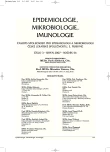Immunogenicity of Vaccines Against Viral Hepatitis A and B in the Population above 40 Years of Age – Impact of Risk Factors
Imunogenita vakcín proti virovým hepatitidám A a B u osob starších 40 let – vliv rizikových faktorů
Imunitní reakce po očkování proti virové hepatitidě A (HAV) a virové hepatitidě B (HBV) může být ovlivněna řadou faktorů. Mezi nejdůležitější patří zejména věk, pohlaví a tělesná hmotnost.
Cíl práce:
tato prospektivní randomizovaná studie hodnotila imunogenitu dostupných vakcín proti VHA a VHB u osob starších 40 let a její ovlivnění rizikovými faktory.
Materiál a metodika:
očkovaní byli rozděleni do 3 skupin podle aplikované vakcíny. V každé skupině bylo zároveň rovnoměrné zastoupení podle věku, pohlaví a tělesné hmotnosti. Vakcíny byly všem aplikovány i.m. do deltového svalu. Skupina 1 byla očkována do levého deltového svalu kombinovanou vakcínou TwinrixTM (GSK) proti VHA a VHB; skupina 2 vpravo vakcínou HavrixTM (GSK) proti virové hepatitidě A a vlevo vakcínou Engerix-BTM (GSK) proti virové hepatitidě B; skupina 3 vpravo vakcínou VaqtaTM (Sanofi Pasteur) proti virové hepatitidě A a vlevo vakcínou HB VAX PROTM (Sanofi-Pasteur) proti virové hepatitidě B. Výsledky: 1 měsíc po ukončení kompletního očkování byla séroprotektivita (SP) anti-HBs: 92 %; 80 % a 71 % a séropozitivita (S+) anti - VHA: 97 %; 99 % a 99 % ve skupině 1, 2 a 3. Anti-HBs SP byla statisticky významně vyšší ve skupině 1. Anti-HAV S+ byla porovnatelně stejná (bez významného rozdílu) ve všech třech skupinách.
Závěr:
prokázal se vliv věku – imunitní odpověď klesá s narůstajícím věkem. Nejnižší imunogenitu vakcín proti VHA a VHB vykazovaly osoby starší 60 let. Muži dosahovali nižších průměrných geometrických titrů protilátek (GMT) i séroprotektivity než ženy. Prokázala se i závislost na tělesné hmotnosti. Nejnižší imunitní odpověď vykazovaly obézní osoby. Reakce anti-HBs byla významně ovlivněna výběrem očkovací látky. Kombinovaná vakcína proti VHA a VHB (TwinrixTM) vyvolala vyšší anti-HBs SP a srovnatelnou anti-HAV S+ v porovnání s ostatními monovalentními vakcínami u osob starších 40 let.
Klíčová slova:
vakcína proti VHA a VHB – imunogenita – anti-HBs – anti-HAV – pohlaví – BMI.
Authors:
R. Chlíbek 1
; J. Smetana 1
; R. Šindelář 1; B. Čečetková 2
; R. Prymula 1; I. Kohl 3
Authors‘ workplace:
Fakulta vojenského zdravotnictví UO, Hradec Králové
1; Thomayerova všeobecná fakultní nemocnice, Praha
2; GlaxoSmithKline, Praha
3
Published in:
Epidemiol. Mikrobiol. Imunol. 56, 2007, č. 3, s. 119-128
Overview
The immune reaction following vaccination against viral hepatitis A (HAV) and viral hepatitis B (HBV) can be influenced by a variety of factors. Among the most important are age, gender and body weight.
Study objective:
This prospective randomized study compared immunogenicity of available vaccines against HAV and HBV infections in the population above 40 years of age and the impact of risk factors.
Material and Methods:
The vaccinated subjects were divided into 3 groups based on the vaccine used. Within each group, the subjects were equally distributed by age, gender and body weight. The vaccine was always applied intramuscularly in the deltoid. Group 1 was given the combined vaccine TwinrixTM (GSK) against HAV and HBV infections in the left deltoid; group 2 was vaccinated with the HavrixTM vaccine against HAV (GSK) in the right deltoid and with the Engerix-BTM vaccine against HBV (GSK) in the left deltoid; group 3 received the VaqtaTM vaccine against HAV (Sanofi Pasteur) in the right deltoid and the HB VAX PROTM against HBV (Sanofi - Pasteur) in the left deltoid.
Results:
The following anti-HBs seroprotectivity rates: 92 %, 80 % and 71 %, and anti-HAV seropositivity rates: 97 %, 99 % and 99 %, were observed at 1 month after the end of the complete vaccination in groups 1, 2 and 3, respectively. The anti-HBs seroprotectivity rate was statistically significantly higher in group 1. The anti-HAV seropositivity rates were comparable (did not significantly differ) in all three study groups.
Conclusion:
The impact of age was revealed: the immune response decreases with increasing age. The lowest immunogenicity of the vaccines against HAV and HBV infections was observed in subjects above 60 years of age. Males achieved lower geometric mean titres (GMT) of antibodies and lower seroprotectivity rates compared to females. The impact of body weight was also observed, with the obese subjects showing the lowest immune response. The anti-HBs reactivity was significantly influenced by the vaccine used. The combined vaccine against HAV and HBV infections (TwinrixTM) induced higher anti-HBs seroprotectivity and comparable anti-HAV seropositivity when compared with the other monovalent study vaccines in the population above 40 years of age.
Key words:
vaccine against HAV and HBV infections – imunogenicity – anti-HBs – anti-HAV – gender – BMI.
Labels
Hygiene and epidemiology Medical virology Clinical microbiologyArticle was published in
Epidemiology, Microbiology, Immunology

2007 Issue 3
Most read in this issue
- Clinically Important β-Lactamases of Gram-Negative Bacteria: Extended-Spectrum β-Lactamases (ESBL)
- Prion Diseases
- Immunogenicity of Vaccines Against Viral Hepatitis A and B in the Population above 40 Years of Age – Impact of Risk Factors
- ABC Transporter Proteins in Multidrug Resistance of Microorganisms
